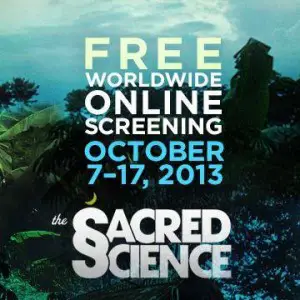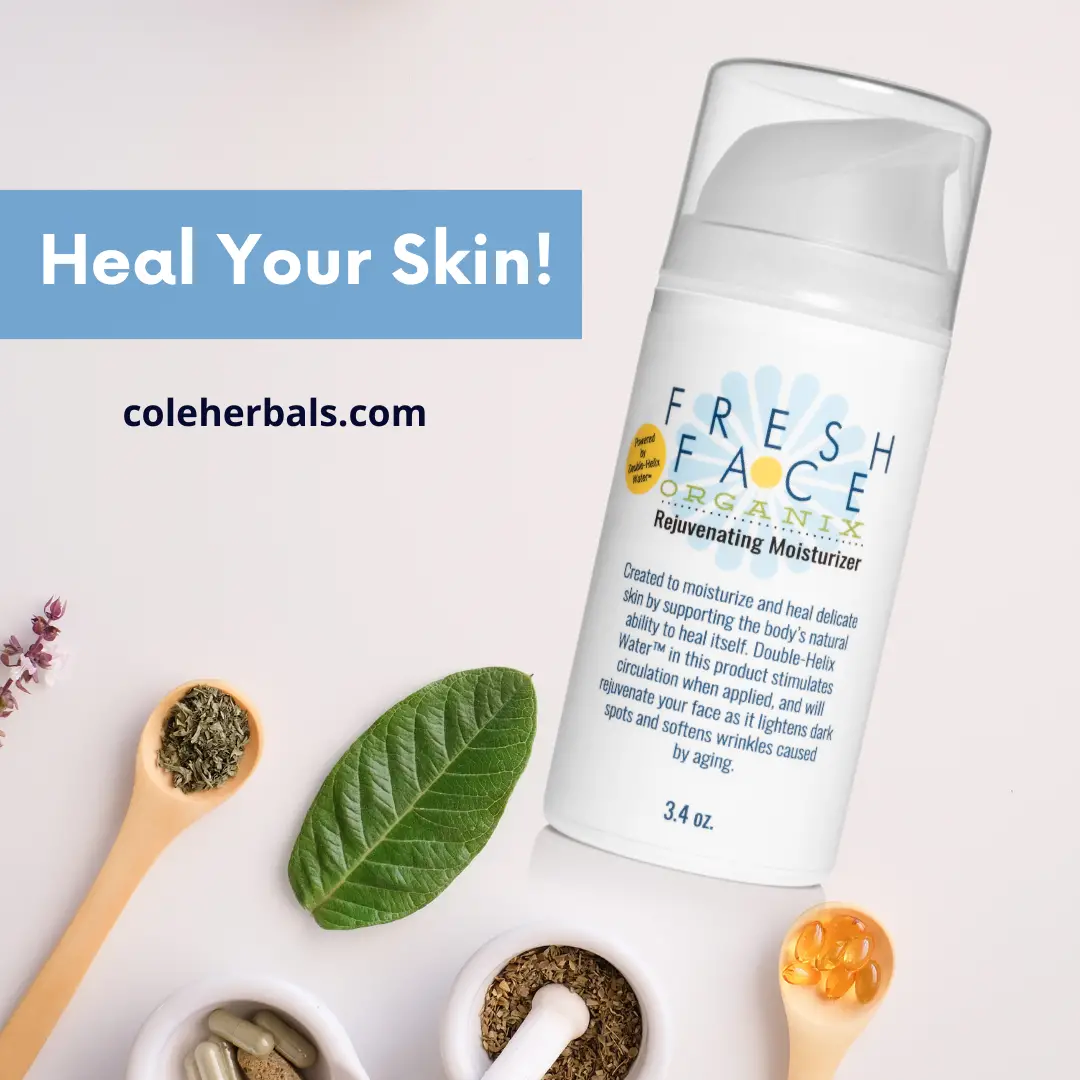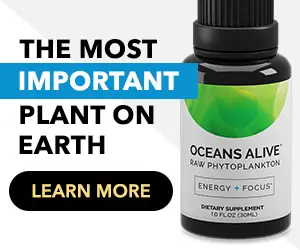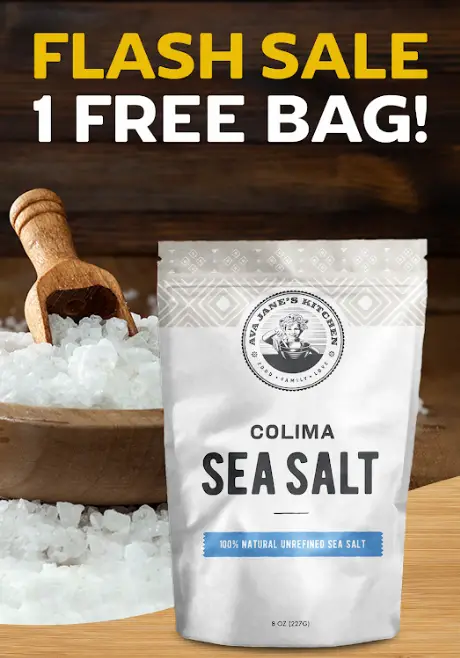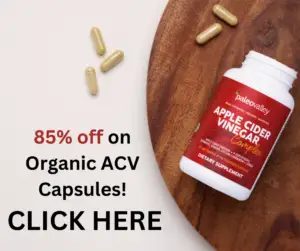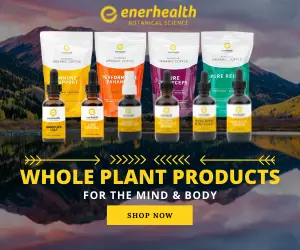Despite winning tons of awards at film festivals from Sydney to Denver, the “alternative” health documentary ‘The Sacred Science’ is still a relative unknown among the holistic health crowd.
The ground-breaking movie chronicles the journeys of eight patients suffering from serious diseases ranging from Parkinson’s to prostate cancer to diabetes as they journey to the Peruvian Amazon Rainforest to live for 30 days under the care of shamans, confront their emotional problems head on, and consume natural Rainforest medicinal plants as they attempt to heal themselves holistically in a way they weren’t able to do through modern medicine.
The film, which came out on DVD about a year ago, was directed by Nick Polizzi, and will be available online as part of a free screening until October 17, as part of an exciting new promotional push. You can register and watch the movie for free by clicking on this link.
Director Nick Polizzi on Amazon healing, when lightning strikes and more
Polizzi recently sat down with AltHealthWORKS.com for an in-depth interview on how the idea for the film came about, how surprised he was by the events and healing transformations that took place, and what it all means for the way we view healing as a society.
AHW: Thanks for joining us, Nick. So the movie came out a little while ago, why the free screening now?
NP: Well we’ve premiered the film at several film festivals, and it came out on DVD a year ago; it’s also been on iTunes for a little while but we haven’t gotten the big push we usually do behind our films.
We want this to be a big event, something to change the game, not to be about just trying to move DVDs. We want to have it be about trying to reach as many people as possible.
AHW: So tell us a little bit more about yourself and how you got started as a director, not to mention how you got into “alternative” and holistic health.
NP: Sure, so I just turned 35 a few months ago, and I graduated from Saint Rose in Albany, New York. I had went to the University of Albany for business and realized I did not want to be an economy or a Wall Street guy so I went to design school instead. That’s also where I kind of got into film making and the creative process. I’ve really gotten into exploring ancient healing traditions that still exist or have remnants, and Amazon Shamanism is just one of the many areas of the world we’re interested in.
We do what we can to preserve this knowledge through film and also on the bog and website, in short videos and articles, to get to the essence of what cultures are all about. These are cultures that are in danger of being wiped off the earth permanently and we want to bring attention to them by revealing how powerful these traditions are.
AHW: Do you have any further documentaries in the works?
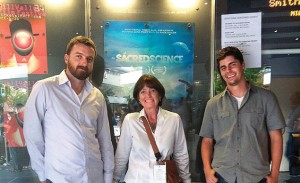
Polizzi (left) at an event for the film. Click the picture to watch it for free now. Photo: blog.fairfield.edu.
NP: Oh yeah, we’ve got films in the works right now that are exploring other regions of the world; we also have films in other genres that you’ll be seeing soon that kind of take a lot of lessons that are taught at the very center of more tribal traditions and applying them to our relationship to the contemporary world.
For instance, at the Ayahuasca ceremony you’re opened up to a bunch of new understandings that kind of contradict what you’ve been thinking about and how you’ve been living during your entire life. It forces you to rethink a lot of the decisions you’ve made and just the path you’re on. So it’s kind of cool, not only are we working to bring light to ancient traditions but when we point the camera at them they’re teaching us lessons that are life-changing and unforgettable. These films are investigations of the cultures themselves and also a re-interpretation of the we’re living as contemporary human beings based on the knowledge presented by these old cultures.
It’s about going into the institutions that we have here in Western society and really understanding where we might be going wrong and where we might be losing out in life. Where we might be losing out on (experiences and knowledge) in life that these cultures still know.
AHW: How did you first find out about “alternative” medicine and also Amazon healing medicine and traditions?
NP: I was hit by lightning at age 16. So that pretty much changed the way I related to the world. I was pretty normal but always kind of had an excitement about nature. But I was a normal high school kid, playing basketball in the driveway in a rainstorm when it happened. After that I was a lot more sensitive to new energies, and sensitive to things I couldn’t quite understand and it scared the cap out of me to be honest.
So, I didn’t have to be talked into alternative medicine. When I found it, I was relieved that people were doing this and using all these methods to put a name on things I was experiencing and didn’t have a name for. That’s how I was initiated into alternative medicine.
It literally kind of hit me, it was almost like a life raft for me. It made me realize that I wasn’t alone. It had an opportunity to really get into it with the first two films (‘The Tapping Solution: Try it on Everything’ and ‘Simply Raw:’ Reversing Diabetes in 30 Days,’ both of which he was an editor on) learning about energy tapping and emotional freedom techniques.
AHW: That’s interesting that you did a film on energy tapping, we interviewed Dr. Fred Gallo recently.
NP: Fred Gallo, Gary Craig…Nick Ortner…(One of his high school friends) So he really helped me a lot when I was going through a lot of tough times. I was trying to understand what was going on; I was having out-of-body experiences and a lot of unintended psychic sort-of phenomena were taking place. He was really gifted healer and I was lucky to have him as a best friend. But uh, yeah, we made ‘The Tapping Solution’ together and that was pretty great, and then that led to ‘Simply Raw,’ which I re-edited and am actually now the managing partner of, ‘Simply Raw,’ Reversing Diabetes in 30 Days with Raw Vegan Nutrition.
That was where I started understanding that the plants themselves could interact and interface with the more abstract, ambiguous, spiritual-level energy phenomenon that I was experiencing. I was having out-of-body experiences and having a bunch of different shifts during the day. When I started working with plants, I got the opportunity to study with David Wolfe, he showed me a bunch of amazing things you could do with plants like the different mushrooms, reishi and chaga, and just understanding how that actually shifts the way that you’re perceiving or seeing reality was really incredible to me. So I was getting more into raw vegan nutrition; even more specifically the herbal supplements, teas and tinctures, and it’s been a ride ever since. So that led to ‘The Sacred Science’ which is kind of a combination of the energy healing techniques and herbal medicine, and then combine that people in different cultures that are masters of both of those worlds, that’s kind of how The Sacred Science came up.
AHW: I see, so how did the process of getting the eight people in the movie come about, and how did you…Did they decide to go to the Amazon or did you decide that as the premise of the movie?
NP: I started becoming curious about shamanism about 5-6 years ago, I was a very curious persona and my parents used to always kind of make fun of me because I would just ask question after question. And when I started getting interested in herbal medicine and energy healing I was like, where does all this stuff come from? It seems like it’s definitely old; it didn’t just sprout out of the New Age section of Barnes & Noble one day (laughing)! Where does it come from, you know? Because we looked at this stuff and it has a very contemporary spin, a very pop culture spin on it.
But you look into the origins of just about every traditional or alternative healing technique and it has its roots in indigenous culture. You give me one and I’ll tell you where it comes from, or the general region of where it comes from. You know people think that acupuncture is Chinese medicine; it definitely is, it comes from China, but Chinese medicine has kind of a clinical modern spin. It was called Chinese shamanism until about 120 years ago when they re-coined it as Chinese medicine.
You know, we look at this stuff and I started thinking you know, what the heck is shamanism?
It’s all these traditions and at the heart of them is the shaman or medicine man, witch doctor, there’s all kinds of ways of describing these people. They are the priest or the healer, the person who sort of passes on the tradition and ancestry but is also gifted in the spirit realm, who uses these gifts to heal people and find plants that work medicinally. I thought okay, this is really interesting, every tribe on the planet has some sort of shaman, so we were going to make the movie and I thought where are we going ot go? We were thinking of Siberia; it’s thought of as being the potential birthplace of shamanism, but then we chose the Amazon Rainforest because of the sheer number of plants that grow there.
There are over 65,000 species of plants that grow in the rainforest; it’s over 65,000, the number keeps going up. When we first made the film it was 44,000 but the number keeps going up. And of those, only 3% of those plants have been studied by modern medicine. Less than 3 percent. And out of those 3 percent that have been studied, 25% of the medicines that you see on the shelf, pharmaceuticals on the shelf either come directly from those 3% or they’re synthesized, they’re just synthetic knock-offs of the same plants.
So if all of those medicines come from that 3%, what happens with the other 97%? Sure seems like a wasted opportunity for healing to me. That’s awesome, there’s all these plants down there and it’s got an extremely rich ancient shamanic tradition. So we thought, let’s go to the Amazon.
AHW: And how did you go about finding the patients? Did you go to them or did they come to you?
NP: It was nice to have the resource of the communities of the first two movies. Because all I had to do was send out word to the Simply Raw community saying here, this is what we’re doing. You thought the Simply Raw movie was great with six diabetics going to a healing center in Arizona? Well we’re going to take eight people with even more severe illness into the middle of the Amazon jungle, you know, away from everything. All we had to do was send one email to our list and we had over 400 applications in 48 hours. People who were desperate, you should have seen the applications, their conditions ranged from mild stuff like migraines; I know they aren’t mild, I used to have them, but compared to Stage 4 breast cancer, they are mild. We had people with conditions ranging from migraines to wanting to lose weight, all the way to, “Listen I have probably a month left and I’ve tried everything else, and this might be my only hope.”
So we had to whittle it to eight participants, it was a very heavy task.
AHW: So you tried to have a pretty good cross-section of different ailments people had with Parkinson’s, prostate cancer and breast cancer, et cetera?
NP: Yeah we sort of had a criteria, we had a whole wall of our favorite people, we cut it down to our favorite 60, and it eventually came down to, A. How likely would you be able to handle the jungle? I mean once it got down to 20 or 30, some people said they’d be fine with the jungle but when you start talking about spiders, poisonous snakes and mosquitoes, and the heat and the seclusion and the fact that you’re not going to have access to any kind of electricity and their iPad’s not going to work. They started to realize it’s not going to be a picnic, it’s not going to be Club Med, and a lot of them start jumping off.
We had about 400 and then we sent an email describing the conditions and that number was more than halved to about 150 people. From there we knew we had people who understood the game and would be more likely to last out there.
AHW: I don’t want to spoil the results of how many got healthy and how many didn’t (or didn’t come back), but were you surprised by the results of this landmark healing trip captured on film in The Sacred Science? Did you think they would do better or worse?
NP: I was surprised by…Who got results and who didn’t. Going down there I would never have thought that the person who didn’t make it would be the person who didn’t make it, just because of their general demeanor and toughness (editor’s note: I agree, you’ll have to see the film to find out why); I was surprised by that.
I wasn’t surprised by the fact that people healed. We tried as much as we could to be very unbiased about the editing though because deep down inside like I said, I don’t need to be convinced that subtle energy, hands-on healing methods and herbal medicine is extremely powerful. My team, which is cool, was hand-selected and they were all skeptical. We thought that if everyone was just drinking the Kool-Aid, it wouldn’t be nearly as objective. Our crew was mostly people who were, just, “We’ll see, we’ll see how this goes.”
But anyway, I wasn’t surprised by the healing results, two people came back without the results they wanted, but all seven (who came back) regardless of whether they were healed said they were profoundly changed spiritually and for the better.
The emails I get from them gush about the spiritual openings they had down there that positively influenced their life back up here.
AHW: Can you talk about the combination of spiritual and herbal healing and why it’s so powerful?
NP: If you ask a medicine man what’s different between the spiritual, mental and physical, they’ll tell you that there is none, it’s all one. They don’t really separate the reality into the different categories that we do in the West, they look at it as all being one; that helps their ability to heal intuitively.
Whether or not we’re talking about the placebo effect; it’s funny how people just kind of write off it, in modern medicine, as the placebo effect without really going into the implications of the placebo effect. So you’re saying you believe a pill is going to heal you, a lot of times it does. Which is what modern medicine it doesn’t understand something it just kind of puts a label on it and sort of builds a dismissive attitude around that label, and kind of doesn’t go any further into investigating it; it just goes about its merry way without dealing with the fact that it doesn’t know everything. Modern medicine isn’t really the only answer, there are some things you can’t quite quantify that are extremely powerful. The placebo effect shows that the body can react to your brain’s understanding of something that something will heal you, if you think you can be healed then you will be healed. That’s pretty cool and it’s actually present in modern science. From that perspective I think that we need to readdress our own relationship to our own healing process.
And again, like the medicine men, healing is done by dissolving the barriers between themselves and you, and between their own psyche, their own body and their own spirit. If you dissolve those barriers, you open up the possibility for miracles.
AHW: As far as the Amazon herbal medicines themselves, do you think that there can be a combination between research and using the right herbs? Because of course the shamans have the intuition to pick good ones, but you kind of wonder if they may be picking the right ones. So where do you think we can go once we discover more properties about these plants from a scientific standpoint?
NP: I definitely am of the belief that the full plant, the concoction and the tinctures made by people that live on the land where the plants grow, these are the full package. When you try to isolate certain compounds from a leaf and put them into a pill it’s not going to be nearly as beneficial as the whole plant so to that extent the pharmaceutical companies try to exploit the natural resources of these communities and healing plants, I think they’re going to hit a stumbling block and they already have to some degree.
Because A, these medicines aren’t nearly as potent as the medicines the tribes make themselves. And also, they’re not being getting the access now that the ethnobotanists have to the medicine men and the healers in the jungles used to give them to their plant knowledge, and they had been sort of the ambassadors to them, the pharmaceutical companies, universities, or just the companies themselves. T
They’re dissolving access the companies have to the far reaches of the rainforest tribes and their knowledge has sort of come to standstill because like many human beings, these tribes have realized they’re being exploited now and they’re no longer coughing up their knowledge to the dismay of these pharmaceutical companies which is why I think a lot of research has halted down there.
AHW: Yeah, I was just kind of thinking maybe for example one shaman is using a plant that he intuitively knows will help with cancer but potentially research could identify that another plant may be better for cancer, the whole plant. So I was just thinking maybe research can help to assist the shamans in just getting the right thing for the right person.
NP: That will probably happen; there’s people that are starting to do tests on a lot of this stuff. And speaking to the shaman’s intuitive ability to pick out plants and prescribe an herb or two that he doesn’t even know the name of, sometimes a medicine man will pick out an herb or the night before the ceremony, he is shown the location and he harvests it. It is supposed to work for a person x condition and it usually works. So there’s a lot of that…How do you mimic that without having a connection to the plant, and without going to the ceremonies?
When you participate in these ceremonies you no longer want to categorize and study these herbs from a scientific perspective, because when you’re at the ceremony realize the idea of trying to do that is futile because there’s a larger picture which is much more about your own relationship with your surroundings than about relying on, you know, your doctor to give you an herb to heal your problem. To even get to that knowledge you first have to go through a number of ceremonies that will shift your perspective on why you came down there in the first place.
AHW: Did you participate in the healing ceremonies and try the Amazon herbal medicine?
NP: Yes I certainly did as part of the screening process, ayahuasca (in a ceremony) among many other things is somewhat of a truth serum (and a psychoactive substance that produces many extraordinary effects; editor’s note). You can’t go down there with bad intentions and sit in front of a medicine man in the ceremonies not have it all come out and be revealed; pretty much everything about you, your whole story and your entire house of cards that your existence is based on. Each card being a different fact or something you know about yourself, or a different perspective of a family member or a high school bully that continues to tick around in your brain; all that stuff comes tumbling down. So yeah, I’ve participated in ceremonies as a kind of initiation, so that they knew my intentions were correct).
In terms of drinking or using the herbs well, as we speak I’m sitting here with this crazy cacao smoothie, my favorite thing on the planet with raw cacao nibs from the jungle, they’re one of my quote-unquote my plant allies, I just like, resonate with cacao and maca and other plants from South America really. I’m mixing it with maca too. A lot of people say, these herbs are incredible and they say how can I get down there? And what I try to tell people is that there are also amazing herbs right in their backyard. You will be blown away by a walk guided by a local herbal expert; those herbs can be even more beneficial because they grow near you and help you with some toxins and allergies in your immediate environment. So yeah, I love herbs.
AHW: I recently interviewed a nutritionist who went to the Amazon to work with the tribes and kind of help them to rediscover their “lost knowledge,” and he said there weren’t many shamans where he visited. Have you noticed this?
NP: Well that’s true, this is a delicate issue. People that are losing their tradition. This is the quote-unquote lineage of direct transmission, there’s no written language so when a medicine man dies without passing on his or her knowledge to an apprentice, that knowledge is lost forever because there’s nothing written down. Marc (from the movie) is really a powerful guy, an ethnobotanist and one of the shaman’s apprentices. He’s been trying to reinvigorate the interest in learning from the elders. For us personally a lot of the proceeds from the film (which you can buy here) are going to help us buy land for the institute. We built that center for the film in the jungle before we got there. (The institute down there) is continuing to purchase and protect large tracts of rainforest land and there are all kinds of ways to do it. We’re working with them to help their cause. What’s most important is to get involved and stay tuned because it’s not going to be televised.
For instance you’ve got the Del Monte Dam right now that are threatening to knock out not only, you know, hundreds of indigenous tribes but are also threatening thousands and thousands of species of plants and animals that nobody’s talking about. People are more concerned about stuff like the Robert Snowden saga, I get that there’s importance there but if we don’t have oxygen, the basic things to live (the rainforest has been called the lungs of the planet; editor’s note) then that’s a pretty moot point.
You can get involved by helping out conservation organizations like Amazon Watch that we are big fans of, and figure out what you can do to make sure you’re not hurting the cultures down there.
AHW: So where can people find out more about the documentary and when is the free screening event happening?
NP: Well they can go visit us on Facebook or go to thesacredscience.com/screening and you’re going to see a registration page, just sign up for free to watch the film. We’ll have tons of speakers coming in and bonus features during the screening week until October 17 too. The knowledge is out there and now as fast as possible, we just want to make it available to the world.
AHW: Excellent. So what is the main thing that you think people should be doing with this knowledge after they watch the movie?
Because on one hand you want to get the knowledge out but on the other hand we don’t want to disturb them too much.
NP: I really think people should take interest in their own local cultures, most people, if you live in Australia or Europe or Africa, geez, anywhere, you don’t have to go far to find cultures that live on the land and you’ll find they have their own healing traditions. Most of the time these people have been systematically exploited and you know, persecuted so they’re not really going to be in a very strong position societally. So I think we need to start empowering the indigenous people to live right in our own communities, they have much knowledge and it’s very important to preserve that.
It’s also great to see how vast the (real food and natural medicine movement) is moving, before traveling across the county was like I was living in a desert, I had a cooler in the back of my car with food in it but now you can find a health foods store or Whole Foods anywhere and you don’t need that anymore.
As a culture we’re getting more interested in natural foods and medicines. Well, there’s nobody knows that stuff better than the people that live on this land before we got there. I really feel like we do them a great service by demonstrating your interest in their traditions which are very, very rich healing potential. And also we can do the right thing to show them support since they really need it and they’ve been mistreated for so long.
Instead of looking at the movie and saying, we need to go to the Amazon immediately and get these medicines, I really hope people will look at the big picture, we’re covered in plants, really, and like my friend Daniel Vitalis says, there’s not one plant that grows is not medicinal, it’s just a matter of dosage. So I want people to be curious about these things, to say I want to take action, to consciously explore some of these traditions. Right now you have the ability to explore your own state, city or county and immerse yourself in the traditional healing methods of the people that live with you.
AHW: Thanks for taking the time out to speak with us, Nick!
NP: Thank you for having me.
Reminder: You can watch ‘The Sacred Science’ online for free by clicking on this link.
We hope you enjoy it, and share this valuable information with your friends!
Thanks for installing the Bottom of every post plugin by Corey Salzano. Contact me if you need custom WordPress plugins or website design.


